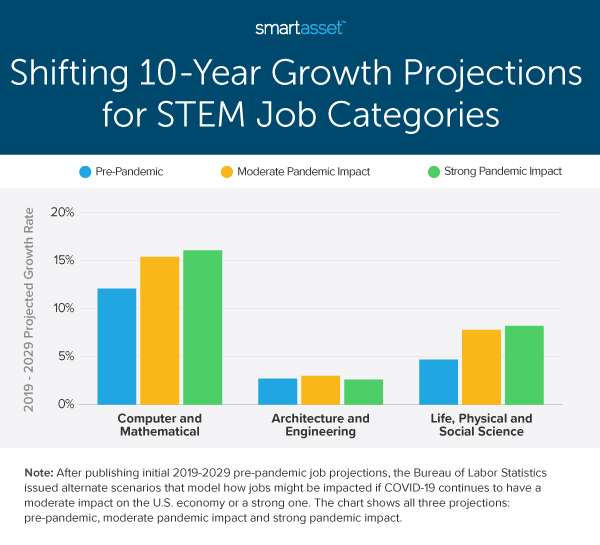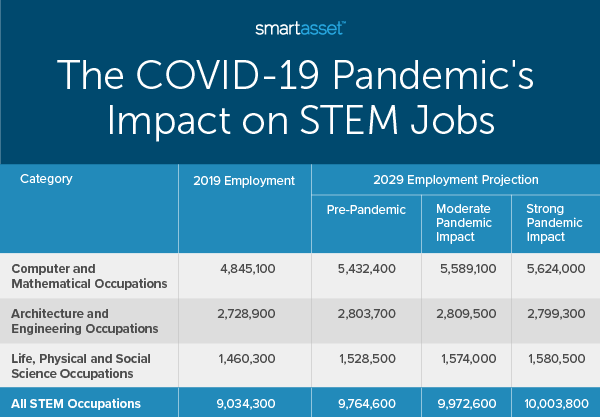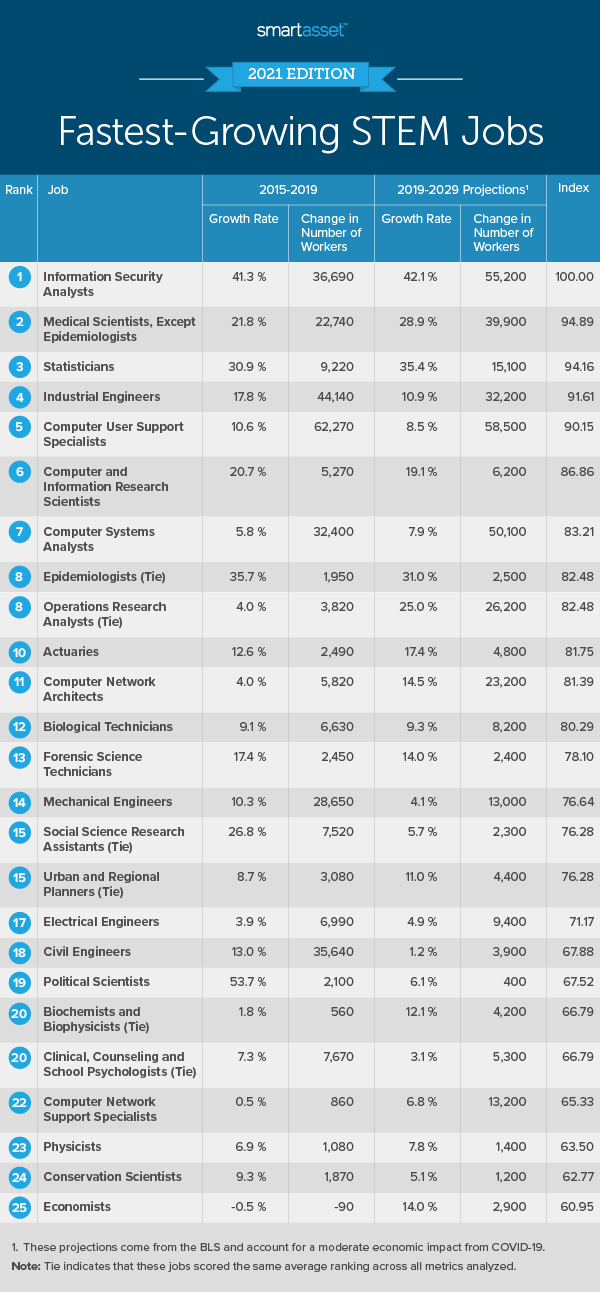The COVID-19 pandemic has caused unprecedented job losses across many industries and occupations. However, STEM jobs have been less affected generally. The 2020 unemployment rates for all three STEM occupational categories were more than three percentage points lower than the overall rate (8.1%). Specifically, the average 2020 unemployment rates for computer & mathematical occupations, architecture & engineering occupations and life, physical & social science occupations were just 3.4%, 3.6% and 4.3%, respectively. Keeping in mind that these industries could offer more opportunities to find jobs and save money, SmartAsset identified the fastest-growing STEM occupations in 2021.
In this study, we looked at how long-term STEM job growth may be impacted by the COVID-19 pandemic and identified the fastest-growing STEM jobs in the U.S. We compared a total of 72 occupations across four metrics: percentage change in employment from 2015 to 2019, gross change in employment from 2015 to 2019, projected employment change from 2019 to 2029 and projected percentage change in employment from 2019 to 2029. For details on our data sources or how we put the information together to create our findings, check out the Data and Methodology section below.
This is SmartAsset’s second annual study on the fastest-growing STEM jobs in the U.S. Check out the 2020 version here.
Key Findings
- Jobs with a computer and mathematical focus rank best again. Last year, seven of the top 10 fastest-growing STEM jobs fell under the category of computer & mathematical occupations. The same is true this year. The seven top-ranking computer & mathematical occupations include: information security analysts, statisticians, computer user support specialists, computer & information research scientists, computer system analysts, operations research analysts and actuaries.
- Medical scientists and epidemiologists take top spots. With the COVID-19 pandemic placing a renewed emphasis on the research of human diseases, two occupations that fall within the physical & social science category rank in our top 10. In projections not accounting for the COVID-19 pandemic, the BLS predicted the occupations of medical scientists and epidemiologists would grow by 6.1% and 4.6%, respectively, over the next 10 years. By contrast, projections accounting for COVID-19 and its effects predict the two occupations will grow by upwards of 28% and 31%.
How Will STEM Be Affected by COVID-19 Long-Term?
Annually, the BLS publishes 10-year growth projections for all jobs in the U.S. After publishing 2019-29 projections in the fall that did not capture the effects of the pandemic, the BLS recently issued alternate scenarios that model how jobs could change if COVID-19 continues to have either a strong impact on the economy or a moderate one. Projections from the BLS show that STEM jobs may actually grow more quickly over the next 10 years than previously projected. The chart below maps pre-pandemic, moderate pandemic impact and strong pandemic impact projections for the three occupational categories of STEM jobs.

According to pre-pandemic estimates, computer and mathematical occupations were expected to grow by 12.1%. In the BLS’ moderate and strong pandemic impact scenarios, computer and mathematical occupations are expected to grow by 15.4% and 16.1%, respectively. Similarly, life, physical & social science occupations are expected to grow by three percentage points more in both alternate scenarios compared to initial projections. The table below shows how percentage growth figures map to expected changes in number of workers.

Taking into account both moderate and strong pandemic impact scenarios, the BLS predicts that in total there will be close to 1 million more STEM jobs in 2029 than there were in 2019. For a comparison, the BLS previously projected that the number of STEM jobs would have increased by about 730,400 from 2019 to 2029.
Computer and Mathematical Occupations
Information security analyst jobs lead the pack as the fastest-growing STEM jobs, moving up from the No. 2 spot last year. Between 2015 and 2019, the number of information security analysts grew by almost 36,700 workers, or 41.28%. This is the third-highest growth in number of workers and percentage change across all 72 STEM jobs in our study. According to BLS projections, the occupation of information security analysts will expand by about 42% from 2019 to 2029 with the addition of 55,200 new workers – the highest rate and second-highest gross increase in our study.
Statisticians, computer user support specialists, computer & information research scientists, computer system analysts, operations research analysts and actuaries are the other six computer & mathematical occupations ranking in our top 10. From 2015 to 2019, statisticians had the greatest percentage growth out of the six (about 31%), while computer user support specialists had the largest gross increase (almost 62,300 workers). The BLS predicts that over the next 10 years, the occupation of computer support specialist will continue to overtake computer systems analyst. It is expected to add 58,500 workers, which is the greatest 10-year expected growth in number of workers overall.
Architecture and Engineering Occupations
Industrial engineers are the only architecture & engineering occupation in our top 10 fastest-growing STEM jobs. From 2015 to 2019, the occupation grew roughly 44,100 workers, or 17.83%. That gross four-year change is the second highest in our study. Looking forward, the BLS expects the occupation of industrial engineer to grow by 10.9% in its moderate pandemic impact scenario. This growth would mark the addition of 32,200 new workers – the sixth-highest 10-year increase in number of workers in the study.
Three other types of engineers – mechanical, electrical and civil – rank in our top 20. From 2015 to 2019, civil engineers were the fastest-growing occupation out of the three. The number of civil engineers in the U.S. grew by more than 35,600, or almost 13%, over that time. However, the BLS expects mechanical and electrical engineering occupations to be in higher demand than civil engineering occupations over the next 10 years. From 2019 to 2029, the number of mechanical and electrical engineering jobs is expected to jump by 13,000 and 9,400 respectively, which is much higher than the 3,900 jobs projected for civil engineers over that same time frame. In percentage terms, those increases mark a 4.1% and 4.9% growth in mechanical and electrical engineering jobs, respectively, but only a 1.2% jump in civil engineering jobs.
Life, Physical and Social Science Occupations
Last year, medical scientist (not including epidemiologists) was the highest-ranking life, physical & social science occupation, tying for 10th place with architect (which excludes landscape and naval). It ranks second this year, with the separate epidemiologist job also ranking in our top 10. Across the four metrics we considered, both medical scientists and epidemiologists rank particularly well for their 10-year expected percentage growth. In the moderate pandemic impact scenario, the BLS expects medical scientist jobs to grow by 28.9% and epidemiologist jobs to grow by 31.0%.
Our top 25 includes 10 other life, physical and social science occupations. Biological technicians and forensic science technicians rank best out of the 10. Both occupations rank in the top half for all four metrics we considered. The occupation of biological technicians ranks particularly well for its four-year growth in number of workers (6,630) and 10-year expected growth in number of workers (8,200). The forensic science technicians occupation ranks higher for the two percentage change metrics, with the 11th-highest four-year percentage employment change (17.41%) and the 10th-highest 10-year expected percentage employment growth (14.0%).

Data and Methodology
The Bureau of Labor Statistics (BLS) defines science, technology, engineering and math (STEM) occupations as including computer & mathematical, architecture & engineering, and life & physical science occupations, as well as managerial and postsecondary teaching occupations related to those functional areas and sales occupations requiring scientific or technical knowledge at the postsecondary level. For the purposes of this report, we considered only occupations falling under the first three categories.
To find which STEM jobs are growing the fastest, we compared 72 BLS-defined occupations across the following four metrics:
- Four-year percentage change. Data comes from the Bureau of Labor Statistics and is for 2015 to 2019.
- Four-year growth in number of workers. Data comes from the Bureau of Labor Statistics and is for 2015 to 2019.
- 10-year expected percentage growth. Projections come from the Bureau of Labor Statistics and is for 2019 to 2029. They account for a moderate pandemic impact.
- 10-year expected growth in number of workers. Projections come from the Bureau of Labor Statistics and is for 2019 to 2029. They account for a moderate pandemic impact.
Using the four metrics above, we ranked each occupation in every metric, giving all metrics an equal weighting. We then found each occupation’s average ranking and used the average to determine a final score. The occupation with the highest average ranking received a score of 100. The occupation with the lowest average ranking received a score of 0.
Saving Tips for STEM Workers
- Contribute to a 401(k) or IRA. One of the best ways to save is through a retirement savings account. A 401(k) is an employer-sponsored defined contribution plan in which you divert pre-tax portions of your monthly paycheck into a retirement account. Some employers will also match your 401(k) contributions up to a certain percentage of your salary, meaning that if you chose not to contribute, you are essentially leaving money on the table. Our 401(k) calculator can help you determine what you saved for retirement so far and how much more you may need. If your employer does not offer a 401(k) plan, an IRA is another great option.
- Consider professional help. A financial advisor can help you make smarter financial decisions to be in better control of your money. Finding the right financial advisor doesn’t have to be hard. SmartAsset’s free tool matches you with financial advisors in five minutes. If you’re ready to be matched with local advisors that will help you achieve your financial goals, get started now.
Questions about our study? Contact us at press@smartasset.com.
Photo credit: iStock.com/sanjeri
